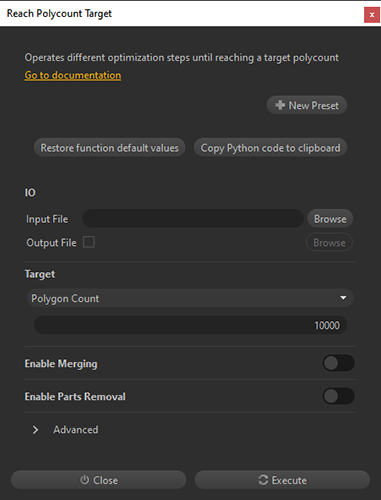Plugins

With Pixyz Studio, it is possible to build and share powerful plugins with the integrated scripting interface.
A plugin is written in Python and can be combined with the XML language to create a custom interface inside the application.
Why plugins?
Plugins can be created in Pixyz Studio for 2 distinct purposes:
- Add custom functionalities and behavior to Pixyz Studio, by creating dedicated Data Preparation tools with their own interface/menu/button, for example to automate repetitive tasks
- Encapsulate Data Preparation scenarios to be executed in Pixyz Scenario Processor for AWS, a batching/automation software
NOTE Plugins developed for Pixyz Scenario Processor for AWS should be created and tested within Pixyz Studio, before being published to be run in Pixyz Scenario Processor. More information here.
About Pixyz Scenario Processor for Amazon Web Services
Unity has sunset Pixyz Scenario Processor for Amazon Web Services (AWS) and is no longer available to new customers. You can continue to use the on-premises packages of Scenario Processor with an existing license. If you are an existing user and already have a Pixyz on AWS entitlement, you can continue to use Scenario Processor from your AWS tenant. If you use Pixyz on AWS, you can continue to use Scenario Processor from your AWS tenant. Existing scenarios and plugins that you have published from Pixyz Studio 2022.1 remain compatible with the existing instances of Scenario Processor for AWS.
If you are interested in a cloud-based transformation solution, a consumption-based solution, or a pay-as-you-go solution, contact our Client Partner team for information about Unity Cloud Platform and its services.
How are plugins developed?
Plugins can be developed:
- By you: Plugins can be easily created from scratch using the Plugin Editor, a dedicated tool for novice users wishing to start developing Data Preparation scenarios embedded in plugins. Advanced developers can use the scripting API and their favorite IDE (see Creating a Plugin), without using the Plugin Editor.
- For you: Please contact Pixyz/Unity if you are interested in the creation of a bespoke scenario, based on your specific Data Preparation process.
Editable plugin versus the published plugin
A plugin is composed of :
- One or several Python script files (.py): they embed the Data Preparation code to execute
- An XML file (.xml), that exposes the arguments to feed as input/output to the script(s)
- Python modules dependencies
By default, a plugin is editable: all its files are accessible and can be modified, within Pixyz Studio using the Plugin Editor, or outside using an IDE.
A plugin that can be edited is an Editable plugin.
A plugin can be published in the form of a binarized archive file, with a .pxzext extension. It is then called a Published plugin, and can be run either by Pixyz Studio, or by Pixyz Scenario Processor for AWS.
A Published plugin, is an encapsulated, non-editable plugin, ready to be installed and used.
A Published plugin executed in Pixyz Scenario Processor for AWS is called a Scenario plugin.
Plugins folder locations
In order to be loaded and executed in Pixyz Studio, plugins must be placed in one of the following predefined locations on a computer:
- ProgramData folder (%programdata%/PixyzStudio/plugins): place a plugin folder here to make it available for all computer users (see Creating a Plugin) - recommended location
- AppData folder (%appdata%/PixyzStudio/plugins): place a plugin folder here to restrain plugin access to the concerned user (see Creating a Plugin)
- Pixyz Studio installation directory (PixyzStudioInstallationDirectory/bin/plugins): folder where default plugins are located, when existing - do not modify
At startup, Pixyz Studio loads all the plugins located in these 3 folders.
WARNING Plugins cannot be loaded from a different location than these 3 locations!
Related topics
Refer to the following topics for plugin creation and management: